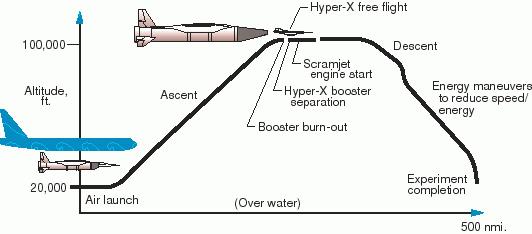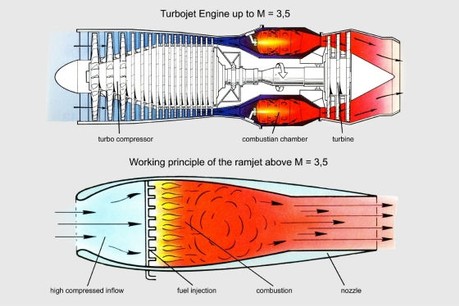X - 43 Ramjet - Machtres Fighters
Main menu
- index
- Air Services
-
Planes
- list
- Weapons
- Gallery
- transport
- liners
- X projects
- Air Forces
- Air Disasters
- red-bull
- Specials
- Choppers
- History
- Aircraft Carriers
-
Information
- Argentine
- Space
X - 43 Ramjet
X-
NASA established a multi- Planned X-
Planned X-
Conventional rocket engines are powered by mixing fuel with oxygen, both of which are traditionally carried onboard the aircraft. By eliminating the need to carry oxygen aboard the aircraft, future hypersonic vehicles will have room to carry more payload. NASA Dryden had several major roles in Phase I of the Hyper-
Fly three unpiloted X-
Evaluate the performance of the X-
Demonstrate the use of air-
Provide flight research data to validate results of wind tunnel tests, analysis and other aeronautical research tools used to design and gather information about the vehicles.
As the lead Center for the flight-
For each flight the booster will accelerate the X-
The B-
Modified Pegasus® boosters will serve as the launch vehicles.
On 11 August 1998, the first piece of hardware was delivered to NASA -
The first flight engine was to be mated to the X-
The first X-
This challenging ground and flight-
Unlike jet engines, ramjets have no rotating parts. Ramjets operate from about Mach 2 to Mach 5.
Scramjets (supersonic-
The highest speed attained by NASA's rocket-
NASA will develop, test and fly the Hyper-
The Turbine-
The Next Generation Launch Technology program tasked NASA's Glenn Research Center to lead high-
The mid-
Engine cycle performance and operability;
Reliability & Durability of High Mach turbine components;
Inlet and nozzle integration with engine;
Geae is wokring with NASA GRC to develop the RTA for a new Mach 4+ engine.
The augmentor will transition to a ramburner between Mach 2 and 3 which will then accelerate the vehicle to speeds above Mach 4.
The air-
On 08 October 2003 NASA selected Allied Aerospace Industries of Tullahoma, Tenn., to provide three flight-
The X-
NASA's Langley Research Center, Hampton, Va., is leading a combined U.S. Air Force/industry team in the design and development of the X-
For the three demonstration flights, a Pegasus-
 A ramjet, sometimes referred to as a stovepipe jet, or an athodyd, is a form of jet engine using the engine's forward motion to compress incoming air, without a rotary compressor. Ramjets cannot produce thrust at zero airspeed and thus cannot move an aircraft from a standstill.
A ramjet, sometimes referred to as a stovepipe jet, or an athodyd, is a form of jet engine using the engine's forward motion to compress incoming air, without a rotary compressor. Ramjets cannot produce thrust at zero airspeed and thus cannot move an aircraft from a standstill.
Ramjets require considerable forward speed to operate well, and as a class work most efficiently at speeds around Mach 3. This type of jet can operate up to speeds of Mach 6.
Ramjets can be particularly useful in applications requiring a small and simple engine for high speed use, such as missiles, while weapon designers are looking to use ramjet technology in artillery shells to give added range: it is anticipated that a 120-
A ramjet is designed around its inlet. An object moving at high speed through air generates a high pressure region in front and a low pressure region to the rear. A ramjet uses this high pressure in front of the engine to force air through the tube, where it is heated by combusting some of it with fuel. It is then passed through a nozzle to accelerate it to supersonic speeds. This acceleration gives the ramjet forward thrust.
A ramjet is sometimes referred to as a 'flying stovepipe', a very simple device comprising an air intake, a combustor, and a nozzle. Normally the only moving parts are those within the turbopump, which pumps the fuel to the combustor in a liquid-
By way of contrast, a turbojet uses a gas turbine driven fan to compress the air further. This gives greater efficiency and far more power at low speeds, where the ram effect is weak, but is also more complex, heavier and more expensive, and the temperature limits of the turbine section limits the top speed and thrust at high speed.
Ramjets try to exploit the very high dynamic pressure within the air approaching the intake lip. Most ramjets operate at supersonic flight speeds and use one or more conical (or oblique) shock waves, terminated by a strong normal shock, to slow down the airflow to a subsonic velocity at the exit of the intake. The Inlet is divergent, to provide a constant inlet speed of Mach 0.5.
Combustor
As with other jet engines the combustor's job is to create hot air. It does this by burning a fuel with the air at essentially constant pressure. The airflow through the jet engine is usually quite high, so sheltered combustion zones are produced by using flame holders that stop the flames from blowing out.
Since there is no downstream turbine, a ramjet combustor can safely operate at stoichiometric fuel:air ratios, which implies a combustor exit stagnation temperature of the order of 2400 K for kerosene. Normally the combustor must be capable of operating over a wide range of throttle settings, for a range of flight speeds/altitudes. Usually a sheltered pilot region enables combustion to continue when the vehicle intake undergoes high yaw/pitch, during turns. Other flame stabilization techniques make use of flame holders, which vary in design from combustor cans to simple flat plates, to shelter the flame and improve fuel mixing. Overfuelling the combustor can cause the normal shock within a supersonic intake system to be pushed forward beyond the intake lip, resulting in a substantial drop in engine airflow and net thrust.
Nozzles
The propelling nozzle is a critical part of a ramjet design, since it accelerates exhaust flow to produce thrust.
For a ramjet operating at a subsonic flight Mach number, exhaust flow is accelerated through a converging nozzle. For a supersonic flight Mach number, acceleration is typically achieved via a convergent-
Performance and control
Below about Mach 0.5 they give little thrust and are highly inefficient due to their low pressure ratios.
Above this speed, given sufficient initial flight velocity, a ramjet will be self-
Due to the stoichiometric combustion temperature, efficiency is usually good at high speeds (Mach 2-
Ramjets can be classified according to the type of fuel, liquid or solid; and the booster.
In a liquid fuel ramjet (LFRJ) hydrocarbon fuel (typically) is injected into the combustor ahead of a flameholder which stabilises the flame resulting from the combustion of the fuel with the compressed air from the intake(s). This offers a lower cost approach than a regulated LFRJ requiring a turbopump and associated hardware to supply the fuel.
A ramjet generates no static thrust and needs a booster to achieve a forward velocity high enough for efficient operation of the intake system. The first ramjet powered missiles used external boosters, usually solid-
Integrated boosters provide a more efficient packaging option since the booster propellant is cast inside the otherwise empty combustor. Integrated designs are complicated by the different nozzle requirements of the boost and ramjet phases of flight. Due to the higher thrust levels of the booster a different shaped nozzle is required for optimum thrust compared to that required for the lower thrust ramjet sustainer. This is usually achieved via a separate nozzle which is ejected after booster burnout. However, designs such as Meteor feature nozzleless boosters.
These are a slight variation on the ramjet where the supersonic exhaust from a rocket combustion process is used to compress and react with the incoming air in the main combustion chamber. This has the advantage of giving thrust even at zero speed.
In a solid fuel integrated rocket ramjet (SFIRR) the solid fuel is cast along the outer wall of the ramcombustor. In this case fuel injection is through ablation of the propellant by the hot compressed air from the intake(s). In a ducted rocket a solid fuel gas generator produces a hot fuel-
Even above the minimum speed a wide flight envelope (range of flight conditions), such as low to high speeds and low to high altitudes, can force significant design compromises, and they tend to work best optimised for one designed speed and altitude (point designs). However, ramjets generally outperform gas turbine based jet engine designs and work best at supersonic speeds (Mach 2-
The performance of conventional ramjets falls off above Mach 6 due to dissociation and pressure loss caused by shock as the incoming air is slowed to subsonic velocities for combustion. In addition, the combustion chamber's inlet temperature increases to very high values, approaching the dissociation limit at some limiting Mach number.
Air turboramjet
Another example of this is the Air TurboRamjet (ATR) which has a compressor powered by a gas heated via a heat exchanger within the combustion chamber.
Scramjets
Ramjets always slow the incoming air to a subsonic velocity within the combustor. Scramjets, or "supersonic combustion ramjet" are similar to ramjets, but some of the air goes through the entire engine at supersonic speeds. This increases the stagnation pressure recovered from the freestream and improves net thrust. Thermal choking of the exhaust is avoided by having a relatively high supersonic air velocity at combustor entry.
In the scramjet, the ram air is not slowed to subsonic speeds for combustion and as a result, shocks are not encountered and pressure loss is avoided.
Precooled engines
A variant of the pure ramjet is the 'combined cycle' engine, intended to overcome the limitations of the pure ramjet. It uses liquid hydrogen fuel in a fairly exotic single-
The Reaction Engines Scimitar has been proposed for the LAPCAT hypersonic airliner, and the Reaction Engines SABRE for the Reaction Engines Skylon spaceplane.
Nuclear powered ramjets
During the Cold War the United States designed and ground-
A concept was created by NASA for recombining this thin gas back to diatomic molecules at orbital speeds to power a ramjet.
Bussard ramjet
The Bussard ramjet is a space drive concept that is intended to fuse interstellar wind and exhaust it at high speed from the rear of the vehicle.